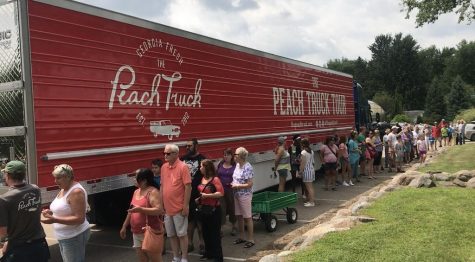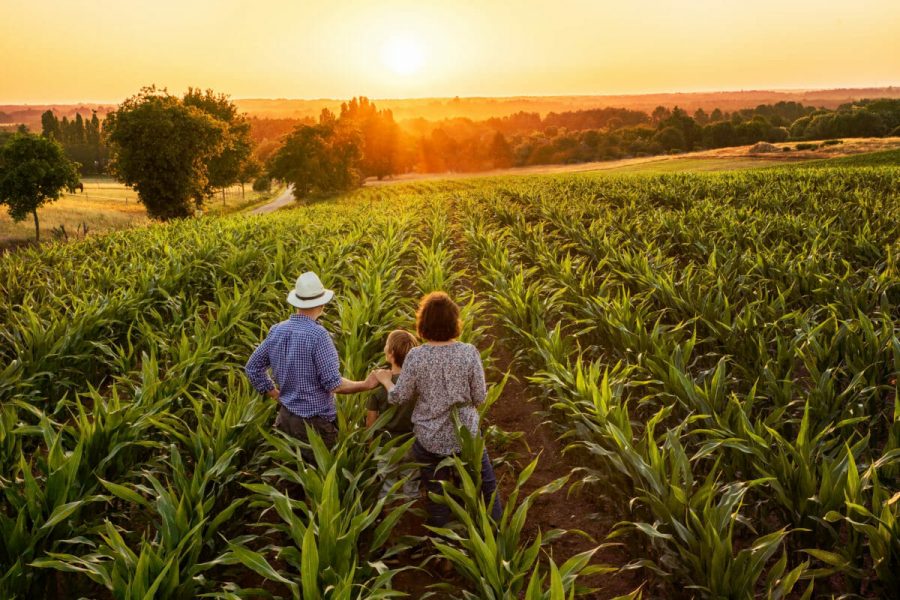Locally grown: America’s family farms
December 13, 2021
The American Farm Bureau reports that one US farm feeds 166 people annually in the United States and abroad. By 2050, farmers will have to grow 70% more food than they do now to support the expected population increase of 2.2 billion.
Around 96% of the 2.2 million farms scattered throughout the United States are operated by families. That’s about 2.1 million family farms located in the United States alone. In 2019, these farms accounted for 86% of farm production.
In 1565, Spanish soldier Pedro Menéndez de Avilés founded St. Augustine, Florida; the oldest permanent European settlement in the United States. Menéndez de Avilés and his fellow settlers relied on farming and foraging to survive. With them came European-style cattle ranching, which means the Florida beef and cattle industry dates back to the 1500s.
These practices have evolved into a cultural staple for American families. From large-scale cattle ranching to backyard vegetable gardens, farming has been completely integrated into society. The history is rich, but it is facing challenges for the future.
The US has lost over 4.78 million family farms in less than a century. Trade wars, low commodity prices and record-high debt have caused this decline in family farms. While net farm income was slightly above the 20-year average in 2019, it was chiefly because of the Trump administration’s financial support.
US farmers have relied on foreign demand for decades. The trade war, which began in July 2018 over China’s economic policies, has negatively affected family farms. The Trump administration’s $28 billion relief fund for the agriculture sector came after arbitrary retaliatory tariffs from China. These tariffs caused family farmers to have a surplus of products without the necessary education or demand to sell.
The relationship between supply and demand is what determines the market price of goods or services. When family farmers have a surplus of products, it skews their supply and demand relationship, which leads to a decrease in commodity prices. These low commodity prices have caused farmers to see record-high debt and bankruptcy filings.
“We still have supply and demand uncertainty,” John Newton, chief economist for the American Farm Bureau Federation said. “If we see prolonged low prices, I wouldn’t expect this trend to slow down.”
Even though prices are rising for consumers, the percentage that farmers receive is dropping. According to the National Farmers Union, farmers only receive around 14.6 cents for each dollar an American consumer spends on food.
In 2019, almost one-third of projected US net farm income was from government aid and taxpayer-subsidized commodity insurance payments, according to the U.S. Department of Agriculture. Family farmers filed 580 Chapter 12 bankruptcies in 2020, which is an 8% rise from 2019 and an eight-year high. These filings have been on the rise since 2014 when there were 361.
The debt that farmers are accruing has led to the highest level of insolvency in the sector since 2002. The Federal Reserve Bank of Kansas City shows that delinquency rates for farm real estate and operation loans increased in 2019 by around 17% and 13%, respectively. In 2020, agricultural debt at commercial banks eased slightly; however, the influx of government payments in 2020 contributed strongly to the growth in deposits, the Federal Reserve Bank of Kansas City reported.
Farm loan repayment problems that are listed under “major” or “severe” grew to 8.3% in 2020. The Federal Reserve Bank of Chicago reports that this has not been seen since 1988 when farmers were facing a crisis because of tight money policies by the Federal Reserve.
While financial issues are one of the most intense problems that farmers face, they also suffer from a small support system. Former agriculture secretary Sonny Perdue said “In America, the big get bigger and the small go out. I don’t think in America we, for any small business, we have a guaranteed income or guaranteed profitability.”
This sentiment was presented at a dairy expo in 2019, where the audience was filled with small-town struggling dairy farmers. When the agriculture secretary shows a lack of concern for small farmers, the future begins to look bleak. This sentiment is not something to be disregarded.
While it is true that the US does not guarantee profitability or even income, this position is not what you want to see from someone who is the voice for your sector.
Bud Chiles, the national director of the American Grown campaign, explained that when the big get bigger, and your small businesses go out, you lose diversity, choice, economic strength, sustainability and the option to have farm-to-table products.
Chiles inherited around 16,000 acres of land from his father, former Florida governor Lawton Chiles. He and his wife have turned the property into Jubilee Orchards, located in Tallahassee, Florida.
Chiles said that his father instilled a love of nature and land into him and his brother, which is what led to the all-organic blueberry farm. He said he is new to the game but has already seen the repercussions of the ‘big getting bigger.’

“The approach the USDA takes to farm policy has got to be reformed, dramatically reformed,” Chiles said. “Because what they’re doing is, they’re continuing this policy of allowing the powerful to crush the weak. And then what they do is they turn around and try to push money out to farmers to make up the difference, you know.”
The money that is being distributed to the agriculture sector by the government is a bandaid for a much larger problem. While it does provide some help, it does not fix the root of the situation. Farmers are acknowledging the national security threat that comes with importing agricultural goods.
Grocery chains and their marketers can pay much less, and thus turn a bigger profit, by importing goods from foreign countries such as Mexico, Peru and Columbia. These chains can make a higher profit by growing cheap in foreign countries and selling for a higher price in the US than they can by paying American farmers a livable wage that compensates them for their labors and risks.
“The marketers have control over the supply, they have control over the relationships with the large grocery chains,” Chiles said. “And, you know, I can’t go to Costco, or to Publix, or Whole Foods. They don’t want to talk to me. They want to talk to a marketer that will give them year-round production and don’t have to deal with 50 local farmers.”
In 2018, the UF/IFAS Center for Public Issues Education, in conjunction with Florida A&M University, hosted six small focus groups to determine the biggest challenges facing small farmers in Florida. Seven categories were identified: Cost of Expendables/Economics, Grants and Funding, Regulations, Organic Rules/Guidelines, Weather, Marketing, and Competition.
“The big fish always eat up the little fish. Small farmers don’t have good access and cannot get in on a lot of the larger, good markets,” said one Florida farmer who participated in one of the focus groups.
“Traditionally, a marketer makes somewhere around 8% of the value of what they’re selling for the client, or the corporation, or the service – these guys [agricultural marketers] are making more like 80%, just from making a phone call,” Chiles said. “Not taking any risks, you know, not investing any money, not growing anything. It’s madness, but it’s driven by simple greed.”
These economic conditions have caused farmers to be able to make more money by freezing their produce and selling it frozen than they can by selling it fresh. Chiles said you cannot compete with a government and marketers who are funneling money into a different country’s economy.
“The USDA has to be a strong voice to say to the White House and to the Congress ‘we have to have American farms’,” Chiles said. “We have to solve this problem for American farmers because unless we do that, way too many of them are going to go under.”
Unfortunately, when farmers are faced with these situations, it affects the entire supply chain. Truckers, service providers, feed stores, manufacturers, restaurants, seed and fertilizer companies and almost everything in between are all threatened.
This ripple effect goes deep into the American economy. When a country begins to rely on another country, it loses its independence – a core value for most Americans. This is another reason why farmers like Chiles believe importing goods is a national security threat – it isn’t just farmers who are affected.
To add to the already difficult agricultural environment, the decline of the rural economic conditions is not just affecting sales. It also impacts the mental health of those who work in the agriculture sector.
Farmers do not just lose their farms, they lose their homes.
According to a survey done by the American Farm Bureau (AFB), 88% of Americans trust farmers. An article published in 2020 on AFB’s website said that “farmers are highly trusted to tell the story of agriculture and explain how production practices align with societal values.”
Chiles expanded on this idea, saying that most farmers from his experience are honest and good people who are steady rocks in their communities. The difficulties farmers are facing are harmful to their livelihood, their families and their communities.
In 2016, the CDC analyzed suicide data from the 32 states participating in the National Violent Death Reporting System (NVDRS). The results showed significantly higher suicide rates in five major industry groups, one of which being Agriculture, Forestry, Fishing, and Hunting (in males). These were compared with rates in the total study population.
These rates are almost 50% higher than during the previous farm crisis in the 1980s. The National Alliance on Mental Illness in Minnesota launched a mental health hotline for farmers; in 2019, the University of Minnesota’s Extension program put together a rural stress task force to help farmers cope.
These types of programs are just the beginning of a brighter future. There are campaigns and organizations across the nation that are fighting for the family farmer – Bud Chiles’s American Grown being one of them.
Understanding that small-scale farming has manifold benefits for the economy, environment and general public health is critical to the revival of family farms.
Small farms have a chance to do more for the environment than almost anything else – from respect for ecosystems and biodiversity to carbon farming, small farms have the upper hand in a sustainable future.
Family farmers are much more inclined to maximize water-saving measures than their mega-corporation counterparts. This allows family farms to be crucial players in water conservation. One of the biggest ways this is accomplished is through drip irrigation.
According to the Center for Agriculture, Food, and the Environment at the University of Massachusetts, drip irrigation can save up to 80% more water than other irrigation systems.
Small farms are also large perpetrators of biodiversity. Research conducted by the University of British Columbia found that “smaller farms have higher yields and harbor greater crop diversity and higher levels of non-crop biodiversity” than larger farms.
A problem that the US is facing, that smaller farms can help reverse, is high carbon dioxide emissions. Carbon farming is one of the best practices for small farms to implement.
Carbon farming results in increased storage of atmospheric carbon in the soil. When plants photosynthesize, they remove carbon dioxide from the atmosphere and store it. When they die, the carbon is either stored in the soil for long periods or is released back into the atmosphere.
Carbon farming can offset high carbon emissions, enhance crop production and even purify surface and groundwater by sequestering CO2 into the soil.
According to research conducted by the Marin Carbon Project and published by the Carbon Cycle Institute, “sequestration of just one metric ton per hectare on half the rangeland area in California would offset 42 million metric tons of CO2e, an amount equivalent to the annual greenhouse gas emissions from energy use for all commercial and residential sectors in California.”
These practices are already being implemented in organic agriculture, but there is a great opportunity for more and more farmers to be involved – all it takes is education.
This is when the USDA can use its power for good, as they say. Farmers can make a profit by implementing carbon farming, but there is specific training and education needed. The USDA can lend its voice to make that training available and to encourage small farms to participate.
Chiles said that he is convinced that it will take creating opportunities, creating ladders of success, to really help farmers. This is when organizations such as The Peach Truck, American Grown and others will become vital.

The goal of these campaigns is to set examples for farmers. They offer an alliance that family farms can be a part of, which allows them to sell directly to the consumer.
The demand for locally grown products is there, and selling directly to consumers is the only way to match that demand. There is no other option when local grocery stores refuse to stock local products.
People have to come together to fight for family farmers. Calling out big grocery chains and marketers has its limits. People lead busy lives and oftentimes grab what is on the shelf. The public needs to work together to make the easiest-to-grab and available items locally grown.
Other ways that the community can help local farms is by shopping at farmers’ markets, petitioning your local grocer to stock locally grown foods, buying organic or volunteering. Communities should want it to be unacceptable to have agricultural products from foreign countries when American, locally farmed products are readily available.
When you support local farmers, you are actively uplifting the community and economy as a whole. Educating yourself, your family and your friends on how and why small farms are being impacted can make a big difference in the lives of small-town farmers.
“Now is the time for our country to recognize and call on family farmers’ ingenuity, strength and value to our past and our future. We can have strong local economies, green energy, a clean environment, healthy citizens and good food – all of these start with family farmers.”
– Willie Nelson, Farm Aid President


